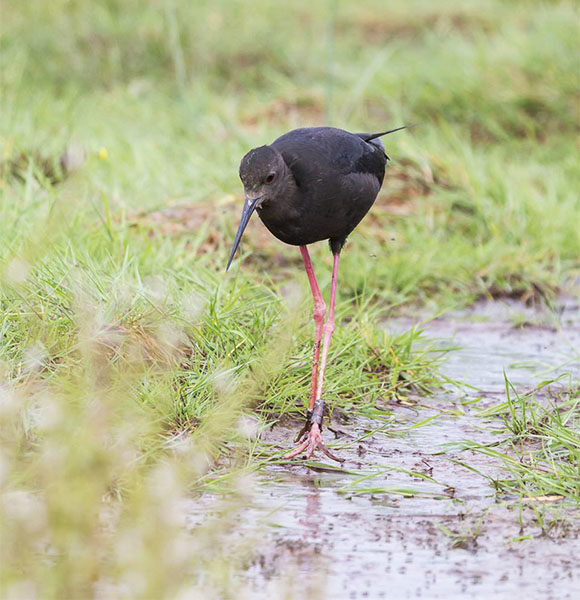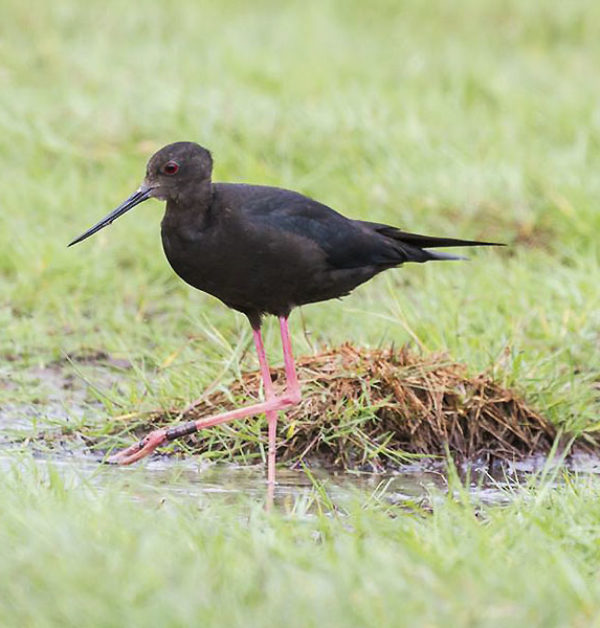Black Stilt - kaki Himantopus novaezelandiae
Black Stilt - kaki Himantopus novaezelandiae

The Ashley-Rakahuri resident black stilt-kaki
Conservation Status
Nationally Critical
Once the common stilt of New Zealand, the black stilt is now critically endangered (just 132 in the wild) with the entire breeding population confined to the Mackenzie Basin of South Canterbury and North Otago.
Adults are distinctive in having entirely black plumage, long red legs, and a thin black bill. Juveniles and sub-adults can easily be mistaken for pied stilts or hybrid black stilt/pied stilt-poaka.
They prefer the shallow waters of invertebrate-rich sidestreams and pools of braided river ecosystems, wading out into deep water if necessary.
Kakī breed mainly in pairs but they can also associate with other pairs of kakī and colonies of pied stilt. They preferentially mate with other kakī, however will breed with poaka if there is not alternative.
Black stilts first breed at 2 or 3 years of age. They begin to arrive on the breeding grounds and set up territories in July. First eggs (nearly always 4) are laid September/October in lined nests in vegetation clumps, open banks, or small depressions. Both male and female incubate the eggs for c.25 days. Chicks fledge after another 4-8 weeks.
A single black stilt-kakī had been breeding on the Ashley-Rakahuri river/estuary area for several years until 2009, but only by mating with a poaka. The (presumably same) bird has been breeding in the sand dune area between the Ashley and Waimkariri River estuaries since 2011.
The Department of Conservation are running a captive breeding programme for kakī, and one of our goals is to create a suitably protected area on the Ashley-Rakahuri for kakī from this breeding programme to eventually be re-introduced here.

Conservation Status
Nationally Critical
Once the common stilt of New Zealand, the black stilt is now critically endangered (just 132 in the wild) with the entire breeding population confined to the Mackenzie Basin of South Canterbury and North Otago.
Adults are distinctive in having entirely black plumage, long red legs, and a thin black bill. Juveniles and sub-adults can easily be mistaken for pied stilts or hybrid black stilt/pied stilt-poaka.
They prefer the shallow waters of invertebrate-rich sidestreams and pools of braided river ecosystems, wading out into deep water if necessary.
Kakī breed mainly in pairs but they can also associate with other pairs of kakī and colonies of pied stilt. They preferentially mate with other kakī, however will breed with poaka if there is not alternative.

The Ashley-Rakahuir's resident kaki
Black stilts first breed at 2 or 3 years of age. They begin to arrive on the breeding grounds and set up territories in July. First eggs (nearly always 4) are laid September/October in lined nests in vegetation clumps, open banks, or small depressions. Both male and female incubate the eggs for c.25 days. Chicks fledge after another 4-8 weeks.
A single black stilt-kakī had been breeding on the Ashley-Rakahuri river/estuary area for several years until 2009, but only by mating with a poaka. The (presumably same) bird has been breeding in the sand dune area between the Ashley and Waimkariri River estuaries since 2011.
The Department of Conservation are running a captive breeding programme for kakī, and one of our goals is to create a suitably protected area on the Ashley-Rakahuri for kakī from this breeding programme to eventually be re-introduced here.


